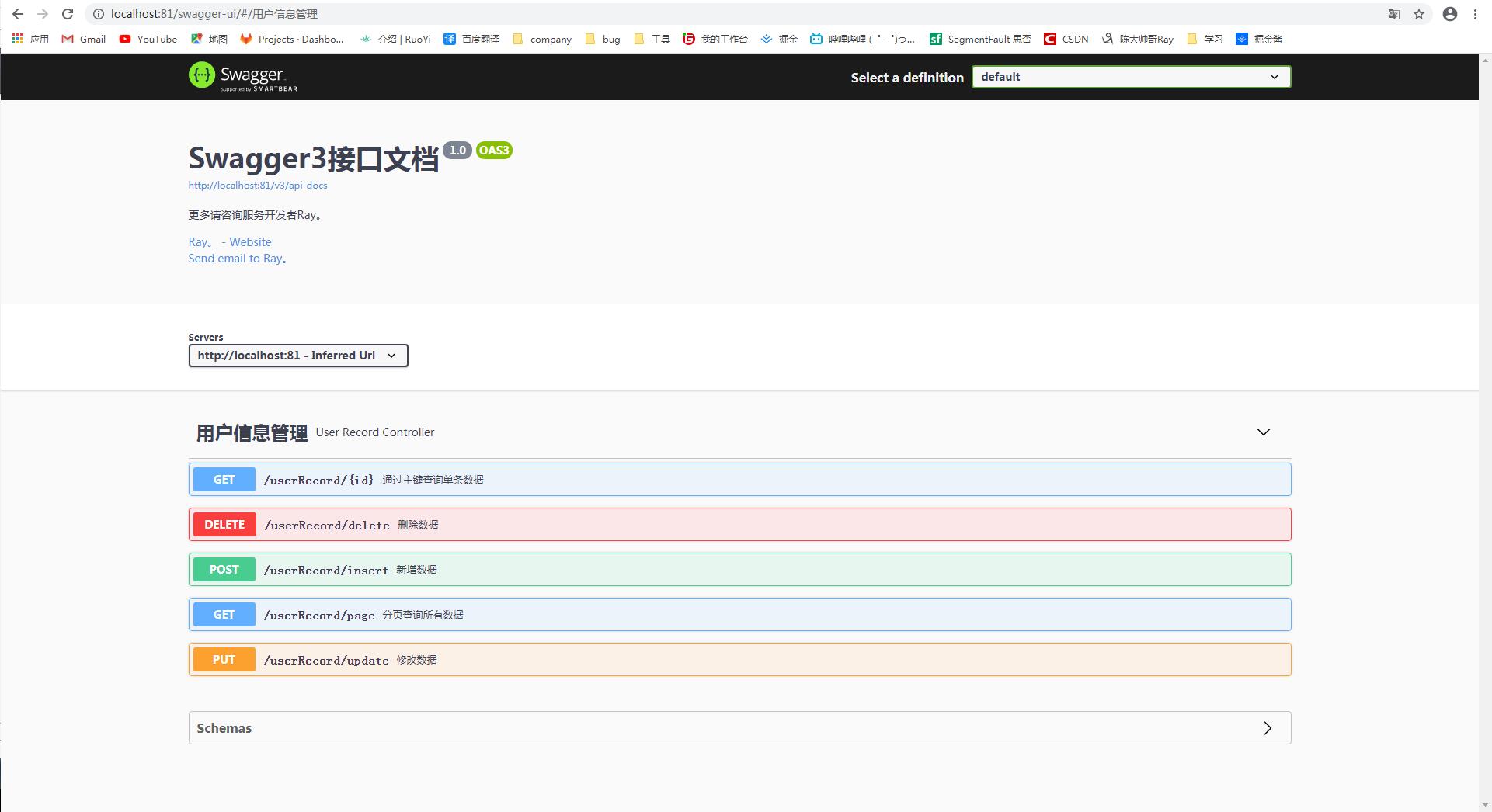SpringBoot整合Swagger3生成接口文档
Posted 陈大帅哥Ray
tags:
篇首语:本文由小常识网(cha138.com)小编为大家整理,主要介绍了SpringBoot整合Swagger3生成接口文档相关的知识,希望对你有一定的参考价值。
前后端分离的项目,接口文档的存在十分重要。与手动编写接口文档不同,swagger是一个自动生成接口文档的工具,在需求不断变更的开发环境下,手动编写文档的效率实在太低。与新版的swagger3相比swagger2配置更少,使用更加方便。
一、pom文件中引入Swagger3依赖
<dependency>
<groupId>io.springfox</groupId>
<artifactId>springfox-boot-starter</artifactId>
<version>3.0.0</version>
</dependency>
二、Application上面加入@EnableOpenApi注解
@EnableOpenApi @SpringBootApplication @MapperScan(basePackages = {"cn.ruiyeclub.dao"}) public class Swagger3Application { public static void main(String[] args) { SpringApplication.run(Swagger3Application.class, args); } }
三、Swagger3Config的配置
@Configuration public class Swagger3Config { @Bean public Docket createRestApi() { return new Docket(DocumentationType.OAS_30) .apiInfo(apiInfo()) .select() .apis(RequestHandlerSelectors.withMethodAnnotation(ApiOperation.class)) .paths(PathSelectors.any()) .build(); } private ApiInfo apiInfo() { return new ApiInfoBuilder() .title("Swagger3接口文档") .description("更多请咨询服务开发者Ray。") .contact(new Contact("Ray。", "http://www.ruiyeclub.cn", "ruiyeclub@foxmail.com")) .version("1.0") .build(); } }
四、Swagger注解的使用说明
@Api:用在请求的类上,表示对类的说明
tags="说明该类的作用,可以在UI界面上看到的注解"
value="该参数没什么意义,在UI界面上也看到,所以不需要配置"
@ApiOperation:用在请求的方法上,说明方法的用途、作用
value="说明方法的用途、作用"
notes="方法的备注说明"
@ApiImplicitParams:用在请求的方法上,表示一组参数说明
@ApiImplicitParam:用在@ApiImplicitParams注解中,指定一个请求参数的各个方面
name:参数名
value:参数的汉字说明、解释
required:参数是否必须传
paramType:参数放在哪个地方
· header --> 请求参数的获取:@RequestHeader
· query --> 请求参数的获取:@RequestParam
· path(用于restful接口)--> 请求参数的获取:@PathVariable
· body(不常用)
· form(不常用)
dataType:参数类型,默认String,其它值dataType="Integer"
defaultValue:参数的默认值
@ApiResponses:用在请求的方法上,表示一组响应
@ApiResponse:用在@ApiResponses中,一般用于表达一个错误的响应信息
code:数字,例如400
message:信息,例如"请求参数没填好"
response:抛出异常的类
@ApiModel:用于响应类上,表示一个返回响应数据的信息
(这种一般用在post创建的时候,使用@RequestBody这样的场景,
请求参数无法使用@ApiImplicitParam注解进行描述的时候)
@ApiModelProperty:用在属性上,描述响应类的属性
Controller层的配置:

@Api(tags = "用户信息管理") @RestController @RequestMapping("userRecord") public class UserRecordController extends ApiController { /** * 服务对象 */ @Resource private UserRecordService userRecordService; /** * 分页查询所有数据 * @param page 分页对象 * @param userRecord 查询实体 * @return 所有数据 */ @ApiOperation("分页查询所有数据") @GetMapping("page") public R selectAll(Page<UserRecord> page, UserRecord userRecord) { return success(this.userRecordService.page(page, new QueryWrapper<>(userRecord))); } /** * 通过主键查询单条数据 * @param id 主键 * @return 单条数据 */ @ApiOperation("通过主键查询单条数据") @GetMapping("{id}") public R selectOne(@PathVariable Serializable id) { return success(this.userRecordService.getById(id)); } /** * 新增数据 * @param userRecord 实体对象 * @return 新增结果 */ @ApiOperation("新增数据") @PostMapping("insert") public R insert(@RequestBody UserRecord userRecord) { return success(this.userRecordService.save(userRecord)); } /** * 修改数据 * @param userRecord 实体对象 * @return 修改结果 */ @ApiOperation("修改数据") @PutMapping("update") public R update(@RequestBody UserRecord userRecord) { return success(this.userRecordService.updateById(userRecord)); } /** * 删除数据 * @param idList 主键结合 * @return 删除结果 */ @ApiOperation("删除数据") @DeleteMapping("delete") public R delete(@RequestParam("idList") List<Long> idList) { return success(this.userRecordService.removeByIds(idList)); } }
五、Swagger界面效果

Swagger的访问路径由port/swagger-ui.html改成了port/swagger-ui/ 或port/swagger-ui/index.html
以上是关于SpringBoot整合Swagger3生成接口文档的主要内容,如果未能解决你的问题,请参考以下文章
